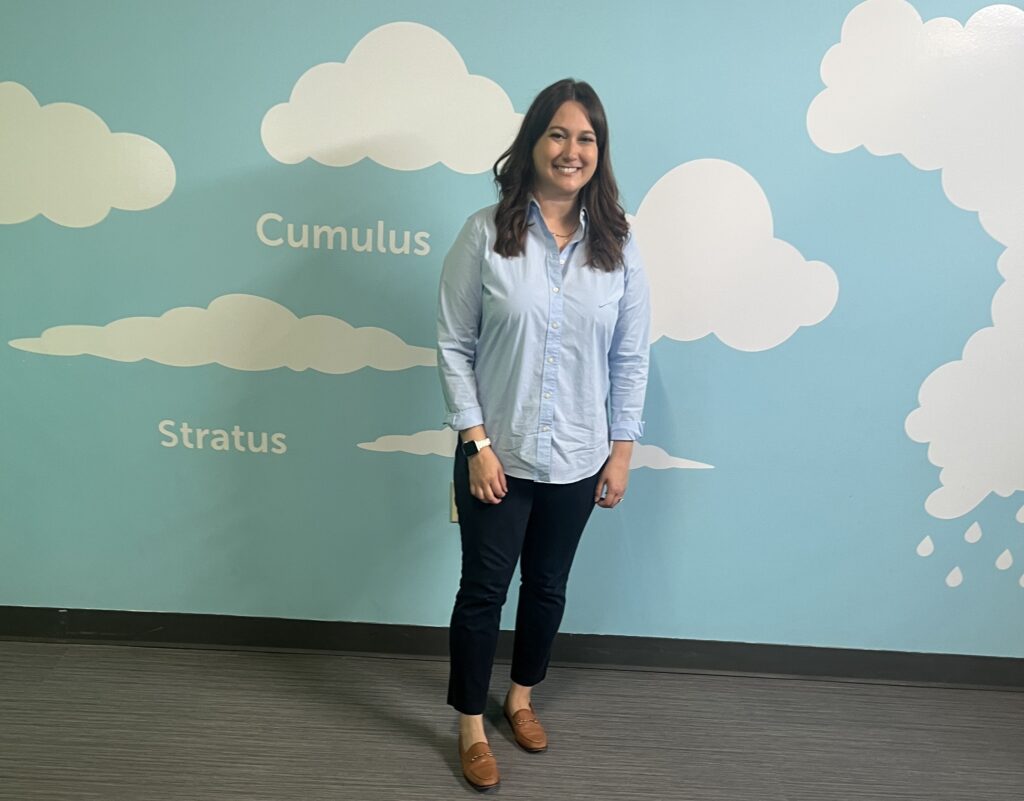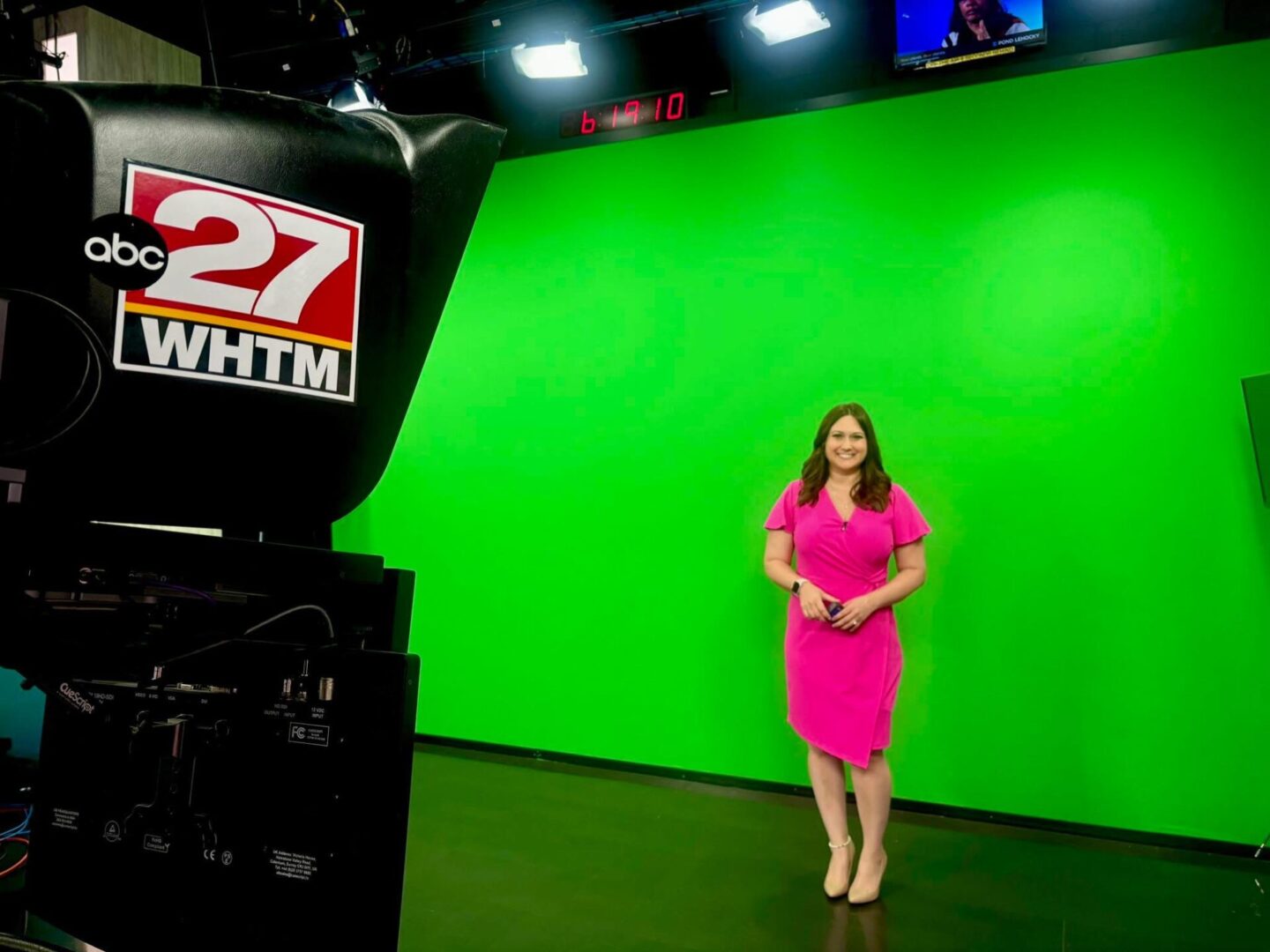This story originally appeared in the November 2025 issue of Town&Gown magazine.
Christy Shields turned a childhood fear of thunderstorms into a passion for understanding the science behind the weather.
Now she works to spark that excitement in other young people.
“I was afraid of thunderstorms growing up as a kid to the point where I annoyed my parents because all I watched was the Weather Channel. I really just wanted to know, when is it going to storm, when do I need to be prepared?” says Shields, a meteorologist who was featured mornings on WTAJ-TV in Altoona before becoming a science educator at Discovery Space of Central Pennsylvania two years ago. “And just because of that fear, it kind of turned into a fascination of, if I learn what is happening with these systems then I won’t be as afraid because I can forecast it myself. So, it went from a fear to a passion because it was really interesting once you knew the science behind it.”
Shields is one of four science educators at Discovery Space, a nonprofit children’s science center in State College. Those science educators help develop curriculum and teach programs from Pre-K to afterschool, at day camps on off-days in the State College and Bellefonte school districts, and at summer camps, and do other community outreach including STEM nights, events at local libraries in Centre and some surrounding counties, and field trips at Discovery Space. Shields also teaches science to a homeschool group.
“It’s creating that curriculum and then taking it and teaching the kids in the classroom,” says Shields, who calls her colleagues “phenomenal.”
Shields, a 2013 Penn State meteorology grad, is also the partnership lead for the Materials Research Science and Engineering Centers at PSU.
“I’m with them on a grant to take what they’re doing in the lab and bringing it to outreach to kids,” she says. “I’ve been working with multiple lab groups at Penn State that are materials research scientists, taking what they’re doing, their very complex science, and helping them create really engaging activities to bring to students, mainly ages 8 to 13. … It all goes back to getting kids excited to learn about science.”
Shields still fills in from time to time on WTAJ and its Nexstar sister station, WHTM in Harrisburg. And she continues forecasting the weather daily on her social media channels and her website/blog, wxshield.com, where she also posts occasional science and travel articles. Her blog includes reports on weather trends.
This past summer (defined meteorologically as June through August) was the 15th-warmest in State College, where records date back to 1893, Shields says. Our average temperature (an average of the day’s high and low) in the summer of 2025 was 71.7 degrees. The COVID summer of 2020 was the warmest on record locally, averaging 73.5 degrees.
One of the reasons for higher average summer temperatures is warmer nights, Shields says.
“Where we have been warming has been at night, so it’s not as noticeable because it’s while you’re sleeping,” she says. “Typically, our temperatures can dip pretty low in the summer if it’s a clear night, if it’s a calm night, and we’ve noticed that there’s been a trend toward warmer nights in the past couple of years.”
Here are more highlights from our conversation, including Shields’ long-range forecast for the winter ahead:
What prompted you to leave your regular television job to teach science?
Shields: I love meteorology and weather. That’s my favorite thing. That will never go away. But I was finding that those early mornings getting up and being at work at 3:30 were getting a little bit rough. And also, I was finding I was spending time preparing for the outreach I would do because, as a meteorologist on TV, a lot of teachers would contact me and ask me to come teach weather in their classroom or just stop by and do a presentation. I was finding that I was spending more time and excited to teach kids about science more than I was of the day-to-day of being on TV. And so, when this opportunity came up, it felt like a nice way to try this out and see how much I loved it. I still fill in [on TV] from time to time, so I still have that nice relationship but a better schedule.
Growing up, were there any people that inspired you in meteorology?
Shields: It’s interesting because I would say any of the legends in Pittsburgh for meteorology, like Joe DeNardo was a huge inspiration. But I would say my parents more than anything because they never said, “Oh, that’s a silly thing to do.” They were very encouraging to pursue that when it wasn’t something a lot of people were pursuing.
Now, teaching young kids, do you feel like you’re a role model, especially for young girls getting into STEM fields?
Shields: I will say, to backtrack to that last question, I did feel like when I was growing up there were not many female meteorologists on television. I don’t think at the time I recognized that consciously, but definitely there’s less females in the field and represented in STEM. As I went into the field and some of the conflicts that I had faced, I definitely wanted to be [a role model]. I can’t say that I am a role model — I’m not sure — but I would love for that to be the case.
I think it’s really important, especially because a lot of girls I know are afraid of math. At one point there’s this turn where it’s like, “Oh, this isn’t what I should be doing. I’m not good at it so I shouldn’t pursue that” around the middle-school age, and we found that at Discovery Space. So, it’s really exciting to be able to get in those classrooms and represent that, and also get kids excited about science so that they don’t lose that spark of curiosity.

Does [the Centre County and Central Pennsylvania region] more broadly present any unique challenges for a weather forecaster?
Shields: It does. Even in Centre County alone, there’s a lot of microclimates and you’ve got a lot of mountains and valleys. So that presents a lot of forecast challenges because, depending on your back yard and where it sits, [weather] can be completely different. I live on a hill and I can have some snowfall, but as I drive down my hill, by the time I get to the bottom of it, we could have not even a dusting of snow on the ground. So Central Pennsylvania does have its challenges when it comes to forecasting the weather for sure.
As a note, all of the official forecasts are taken either at a university or at an airport. So that’s something to think about is, where is your airport located near your area? Because that’s where that temperature reading’s coming from. That’s where the wind report is coming from. Now, here in Centre County, it’s unique because Penn State has had a long, historic meteorology program and records have been kept since 1893. For comparison, Altoona’s records only go back to the 1950s. So, there is a lot of climate data here in Centre County because of that.
I’ve been surprised at how little snowfall we’ve had in recent years. But maybe that’s just normal?
Shields: In the past five years, there was only one year — 2020 into the 2021 season — where we were actually on average with snowfall; the rest of [the winters] have been really below. Last winter, we only had 20.1 inches of snow. Our average in State College is 43.8 inches of snowfall. Now, that number comes from a 30-year average. So that’s looking at 1991 to 2020. Before that, I think the average snowfall was more around 45 inches, so we have been seeing less snowfall.
Can you give us a preview of the winter ahead?
Shields: You like to look at sea surface temperatures, and we look at the El Nino and La Nina patterns of the Pacific. El Nino is a warming sea surface temperature in the Pacific Ocean; La Nina is a cooling pattern. Currently, we’re neutral, which means it’s not either way, and going into winter, NOAA [the National Oceanic and Atmospheric Administration] is forecasting that it’s going to turn into a slight La Nina. So, it looks like the Pacific Ocean is going to cool a little bit.
I was looking at past patterns of whenever we get a little bit cooler, and typically that means for us locally in Centre County and Pennsylvania that we usually see seasonable weather for winter and maybe slightly above snowfall. Because we’ve been so low on snowfall the past couple of years, only staying around 20 inches, I would say this winter to me — right now in September — looks like it could be an average winter, which would be more in the upper 30 inches to 40-inch [snowfall] range, with what you would expect with winter temperatures.
[Shields cautions that forecasting winter weather in mid-September is risky, and patterns could change. Check her website for updates.]
Do you get flak from people who get mad about forecasts?
Shields: 100 percent, yes. I love winter weather because it to me is the most challenging. A lot of people also don’t realize that the air temperature changes depending on where you are in the atmosphere. Because you can have different air temperatures, it can be rain and then turn to snow and then back to rain by the time you get to the surface, which makes it complicated to forecast snow amounts. If the air temperature is closer into the 30s, you get higher amounts of snow, where if our air is drier and colder — if we’re in the teens — our snowflakes are going to be smaller, so that means less accumulation. It makes it very difficult to forecast, but I also find that’s a fun challenge whenever it is like that. But yes, people do seem to get upset.
I also find it funny because people will get upset that it snows sometimes in April, but that happens every year. We just seem to forget those things happen. I usually grab a snowball and keep it in my freezer and I say the first person who complains about it being too hot in the summer, I’ll throw this snowball at you [from when] you complained about the winter weather! T&G
Mark Brackenbury is a former editor of Town&Gown.



